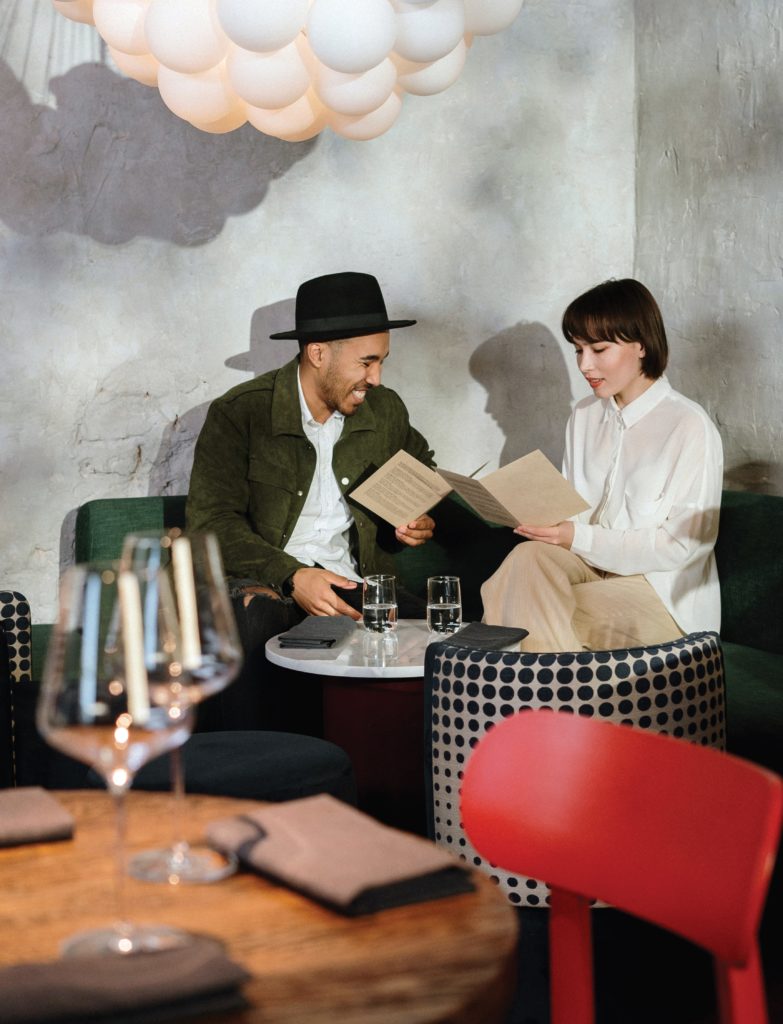Dining by Design
Posted by estiator at 10 July, at 03 : 19 AM Print
After COVID-19, how can restaurant design inspire customers?
By Michael Kaminer

We know how COVID-19 has changed the look of restaurants—spaced-out tables, clear partitions, QR codes on tables, outdoor tents. But what does the pandemic mean for the future of restaurant design? How will we adapt to make patrons feel not just comfortable and safe, but excited and inspired? For Wid Chapman, a New York architect whose firm has designed restaurants, hotels, and homes around the world, color will play an essential role in re-engaging diners. “I’m a fan of color, and this is a time to use it,” says Chapman, founder of Wid Chapman Architects in Manhattan. “Using color strategically is part of this coming out of the bland, limited, confined period we’ve been through. It makes people happy. I have a feeling we’re going to see brighter, more saturated color environments. It was a bit of a trend before COVID, and I think it’s going to become even more in demand now.”
Building multiple “experiences” within a restaurant can also enhance feelings of intimacy in spaced-out dining rooms—and build deeper connections with customers, Chapman tells Estiator.
“An intimate place might be a booth set under a mezzanine, which creates ‘moments’ that are separated but interesting,” Chapman says. “It doesn’t necessarily feel like you’re accommodating COVID, but you’ll be creating environments that will enhance a guest’s comfort level. Customers want to be accommodated within a group of people they know they’re comfortable with, so that will become more of a psychological thing down the road.” At Tribeca Indian hotspot Tamarind, which Chapman designed, the tucked-in booths have become the most sought-after tables, he says.
Spaced-out tables can also diminish the energy of a room if they make it look empty. Chapman suggests a simple and relatively inexpensive fix. “Plants can be very useful to make a room feel less empty, but you want to make sure you do it properly,” he says. “You’ll want to retain an interior landscaper or another expert and make it something special, not just buy a potted plant and throw it in the middle of the room.”
With that in mind, restaurateurs should resist making costly and permanent changes, Chapman says. “You don’t want to create fixed solutions, because we think this is going to be temporary.”
William Oberlin, a partner and cofounder of New York design and branding studio Dutch East Design, agrees. “We always have safety in the back of our minds now, and that will play a role in the decision of where we travel, stay, and play. But we are humans, and we adapt.”

So while expectations for hospitality in the short term Wid Chapman may involve safety, “we’ll see very exuberant and hospitable environments,” Oberlin says. “We want them to reflect our great enthusiasm for being out of the house. We’ll see a lot of fun, experiential design, whimsy, and light.”
For Lesley Hughes-Wyman, partner and principal at MatchLine Design Group in Dallas, flexible options are key. “From an economically minded standpoint, whether it’s outdoors or inside, we recommend multiple smaller tables that can be reconfigured into a larger table depending on group size, or booths with dividers or panels that can be switched out at a moment’s notice for flex configurations,” she told restaurant development + design in May. “Integrating more intimate dining zones will provide both physical distancing and visual cues to help diners feel safe.”
Likewise, “the effects of the pandemic this past year will definitely influence how we experience public spaces moving forward,” Kristen Becker, partner at Seattle-based Mutuus Studio, told Fortune last month. “The way we want to create intimacy [is] not about physical connection but more about visual connection.” A central fireplace that everyone can appreciate was one way the designers achieved that goal at a new Seattle restaurant.
If and when your climate permits, you can also bring your “before times” vibe outdoors, according Eric Robson, principal of RODE Architects in Boston. Robson told Food & Wine he encourages operators to create “an outdoor space that’s a little bit more special” and embodies the style of decor indoors, be it rustic or modern, by repurposing elements like drapery, bookshelves, and planters as separators, depending on what feels on-brand for your business.
Robson told Food & Wine that savvy operators will even leverage COVID necessities like CDC guidelines to further engage customers. “There’s a temptation to just download the CDC poster [about safety guidelines] and tack it up in the restaurant,” Robson said. But restaurateurs can demonstrate a different level of care by creating custom messaging and signage in their own voice that jibes with the concept of the restaurant, he said.
Some designers, though, think the pandemic’s influence on hospitality will eventually fade. Jonathan Knudsen of New York’s Concrete Hospitality told Fortune that projects that have been in the works for years—including two new branded hotels in New York—have had no changes from pre-pandemic designs. Even temporary partitions will be gone by the end of this year, he predicted. His team is even continuing to add communal tables into their restaurant designs.
“We’re social creatures,” he says. “The pandemic has proven that we need that interaction. And you can’t replace that.”
















